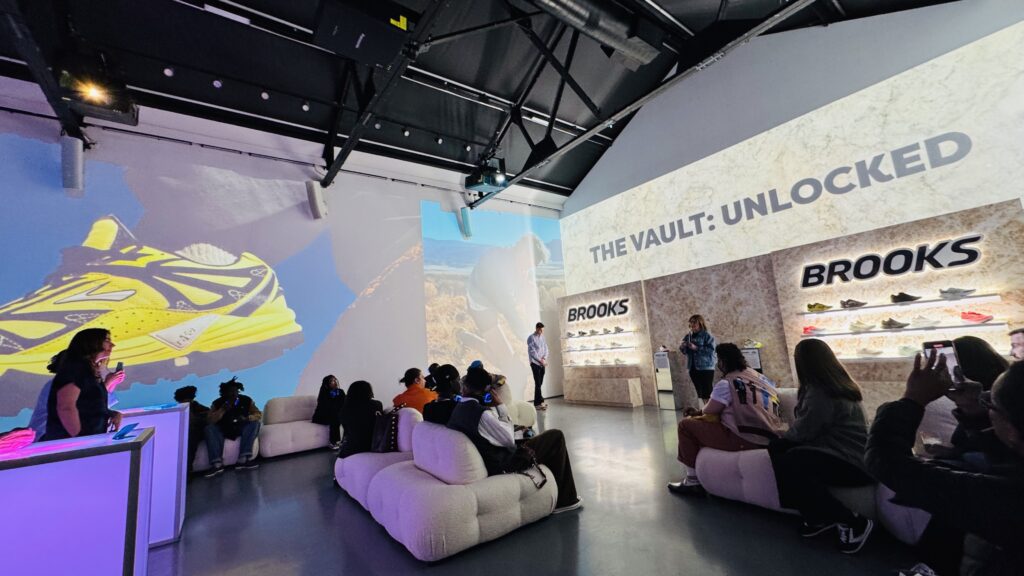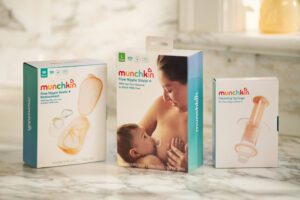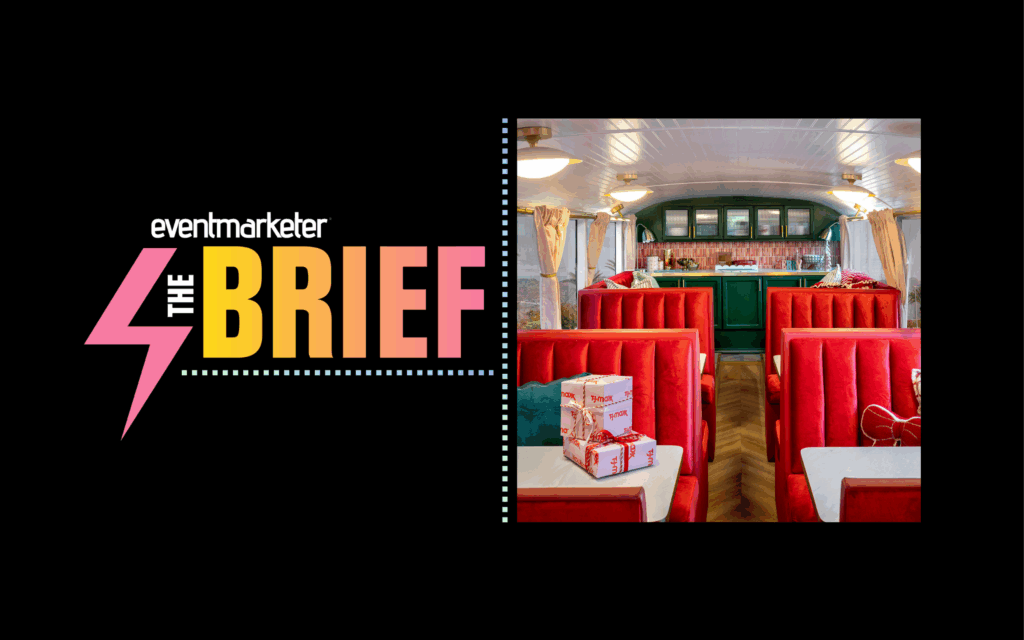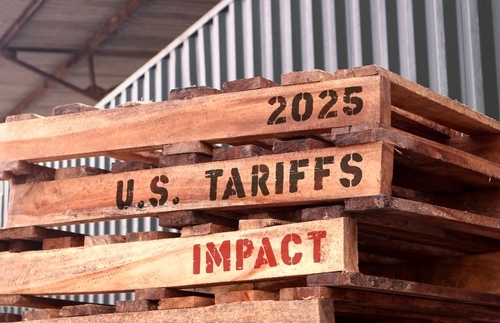As one of the top running brands in the U.S. since the 1970s, Brooks knows its way around a performance running shoe. But some 50 years later, running shoes have literally left the track. They pervade streetwear culture and the fashion world, even crossing generational lines. (Chunky yet comfy “dad shoes,” we’re looking at you.)
Leaning on its heritage and expertise, Brooks Running saw an opportunity to enter the lifestyle space and embark on the next phase of its brand evolution.
The idea is to provide for existing fans while reaching new ones who might be looking for a fashionable, comfortable shoe. “We heard from our community that they really wanted to be able to wear Brooks in more moments of their day,” said CMO Melanie Allen. But it also felt like the right moment along the brand’s journey. “We grew to a point where we were starting to say, it’s probably time that the brand can hold the category outside of run,” she said.
The company held a New York City launch event in May highlighting the new lifestyle line, which revived three styles from the Brooks archives—the Chariot, the Cascadia 1 and the Adrenaline GTS4. Attendees explored running innovations across three decades, alongside the stories of how the original styles came to be and the modernized versions launching in 2025.
We caught up with Brooks Running CMO Melanie Allen and Director of Footwear Merchandising Matt Weiss at the event to discuss the vision behind the launch, its marketing goals, the team’s singular focus on storytelling and the challenges of entering a new category.
Chief Marketer: Why did Brooks decide to make the move into lifestyle?
Melanie Allen, Brooks Running CMO: There were a couple reasons. One, we heard from our community that they really wanted to be able to wear Brooks in more moments of their day. And as we started talking to some collaborators and talking to creators, we also heard from them [that] it might be time. And then the last reason: I think there’s just a point in time in your brand … We grew to a point where we were starting to say it’s probably time that the brand can hold the category outside of run.
CM: Following up on that, what methods do you use to talk to your community?
MA: We have a consumer research team. We call them the “RunSights Lab.” They’re all about gaining insights from runners. We’re talking to runners all the time, so we hear it from that standpoint. We also hear it just in the field. If you’re out with runners over at events, whether you’re running with a community or talking to our store partners, you start to hear a little bit more of that feedback.
CM: What makes you think this initiative will be successful?
MA: We’re keeping it really authentic to the stories and not over-skewing or increasing the line. It’s really about storytelling about the brand and taking those key moments. So I think that’s one of the main reasons—our discipline of making sure it’s just got a great story. And I do think our creative partners are a big component to it as well … You start to see this combination of our world and their world coming together.
CM: Partners meaning the collaborators?
MA: Collaborators. And then we have a longstanding heritage of people in the brand. [Director of Footwear Merchandising] Matt Weiss has been with the brand 20 years. We’ve got many other long-tenured [people], so they remember these shoes. They remember how to build these shoes. We’re able to go back to our partners, [and communicate] that idea that we really brought the expertise to it to bring new foam technology so it’s comfortable, but really every detail is authentic to what it was originally.
CM: Why did you decide to bring back older styles instead of doing something totally new?
MA: It was that storytelling component, and really looking at what we saw in fashion and trends today. We looked back at the vault and we’re like …
CM: You have that stuff.
MA: Yeah. So, let’s start there, with those styles you are seeing. You will start to see things blend a little bit more. You’re taking a modern foam technology, but the look of the old original.
CM: In terms of your target market, do you have one?
MA: Our target market is … that balance of sneaker culture but also blended with that running heritage. They have some experience with running, but are also looking at the fashion side and are able to take what’s happening in running culture right now—running performance in terms of what’s true to running—but then also what’s on trend right now and what you’re seeing in fashion.
CM: Are you involved in runners clubs—which have actually transformed into dating clubs—and things like that?
MA: Yeah. One of the collaborators that we have coming up … is PYNRS, a run club out of Boston. They also have some other product lines, but they’re doing really amazing things in terms of being able to bring in more people and gain access to running. [They] reach out to communities that might not have thought that they could run or were welcome into running.
CM: Matt, can you speak to the design aspect?
Matt Weiss, Director of Footwear Merchandising at Brooks Running: What we’re seeing right now is this incredible melding of performance and lifestyle. That wall out there [at the event] has some of our heritage product that goes back to a more traditional lifestyle product. And then we’ve got some of our pinnacle performance shoes. The response from the market, the consumer, the retailer is, that’s what’s happening in this space right now. Pinnacle performance is driven by this run culture that’s permeating these dating clubs and everything, but you’re seeing people walking around in the streets in pinnacle performance, carbon-plated shoes. It’s this running aesthetic that’s having a moment. You’re seeing it in apparel and you’re seeing it in footwear. For us it’s really exciting because it’s validating a lot of the work we’re doing on our performance side as well as we enter this space.
CM: How about the technology part?
MW: What we tried to do here was honor the past, and make them more comfortable, make them more wearable. So a shoe like this one: the iconic technology at that time is HydroFlow, which was a bag of fluid in the heel that dissipated energy upon heel strike. So we recreated HydroFlow in the heel, but we paired it with our modern foam. What we wanted to do in 2025 is bring back some of our most important shoes from our history, tell those stories, really romance them, obsess over the details of the product. And then I think as we go forward, we’re going to start stretching those stories.
CM: So how are you marketing this to consumers, besides through an event like this?
MA: We’re choosing unique channels to be able to tell this story. First and foremost is retailers. The retailers that we’re partnering with, we’re giving them the tools to be able to tell the story to their consumer group, and their audience is the audience that’s going to attract it the most. So we’re doing special events, local events, bespoke events, with that store.
And then, social. You’re starting to see that, but it’s really about showcasing the story and then being able to find the shoes at our retailers. The third one is we’re doing specific placements and paid, but it’s not a large amount of paid. And then the other is influencers—working with key influencers that can take the product and imagine it and style it and be able to showcase all the different ways you can wear it.
CM: Are the influencers people that you’ve already worked with? Are they all runners?
MA: They’re newer influencers that we’ve formed new relationships with. The majority have some relationship with the run. So, run is part of their life, but they might not necessarily call themselves a runner.
CM: What are the main risks here for Brooks? What are the big challenges?
MA: The main thing for us is keeping it special. It’s about showcasing our heritage, our performance product, and blending that into things that are special and coveted and wanted—and not getting too, so to speak, greedy with it. It’s about brand building more than a big business opportunity. We’re looking at it as, how do you start to incubate and build this line? We’ll keep learning, figuring out what’s working and then continue to build. When you start to see things where we’re blending the modern and the new, it’s going to halo back to the core performance as well.
MW: I’ll build on that. We’ve joked that it’s like holding your breath. It’s kind of easy at first, and then it’s really hard. And I think for us, it’s such a crowded space. How do we differentiate ourselves? The way we do that is just by staying true to our formula. If we start trying to be everything to everybody, it’s going to be really, really hard. We’re starting with a ton of focus and discipline and we just have to maintain that.









